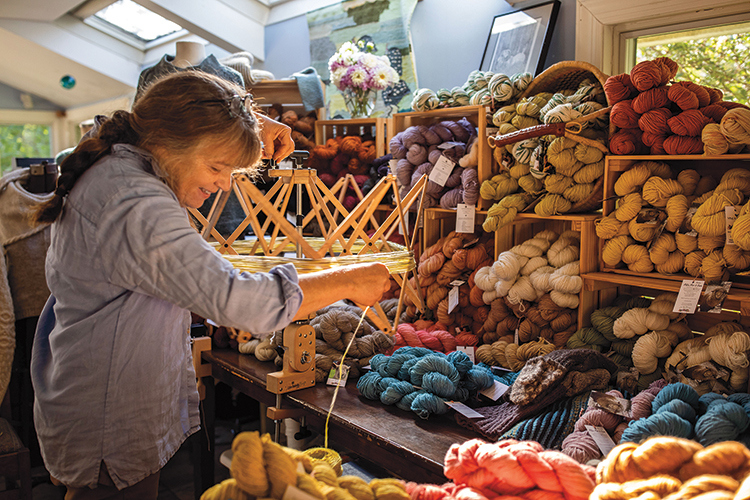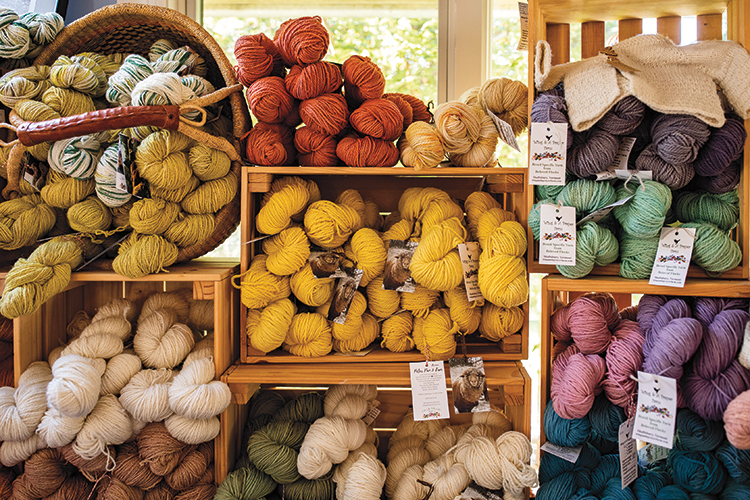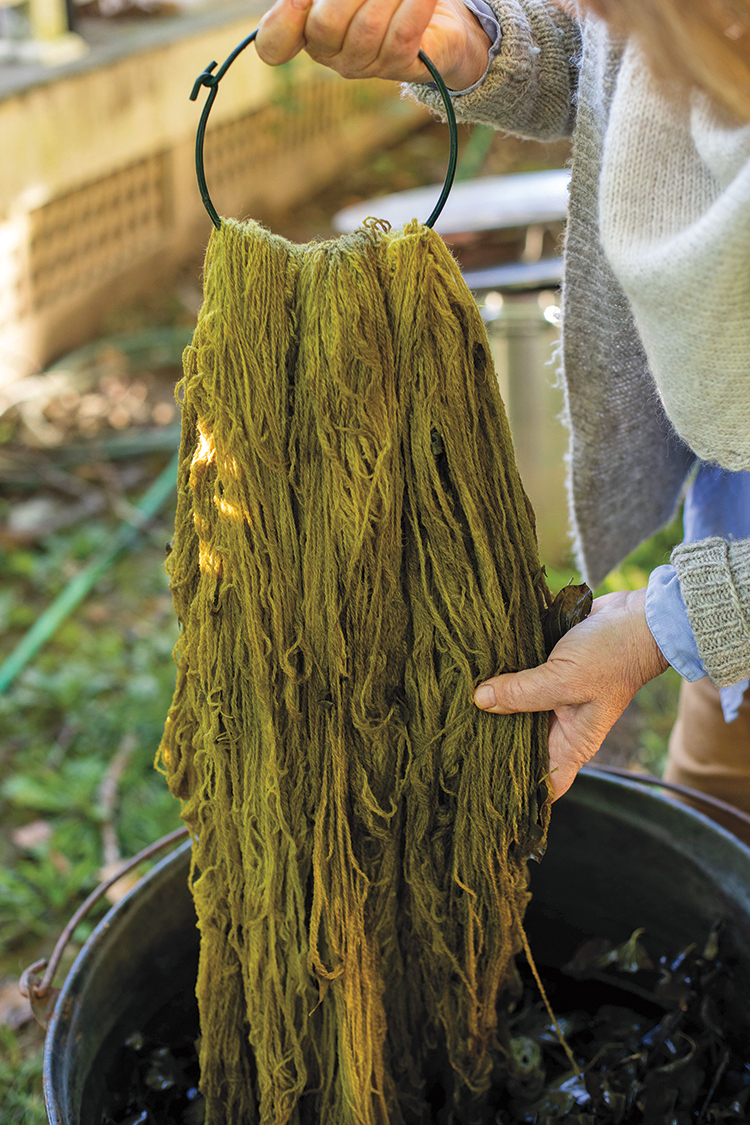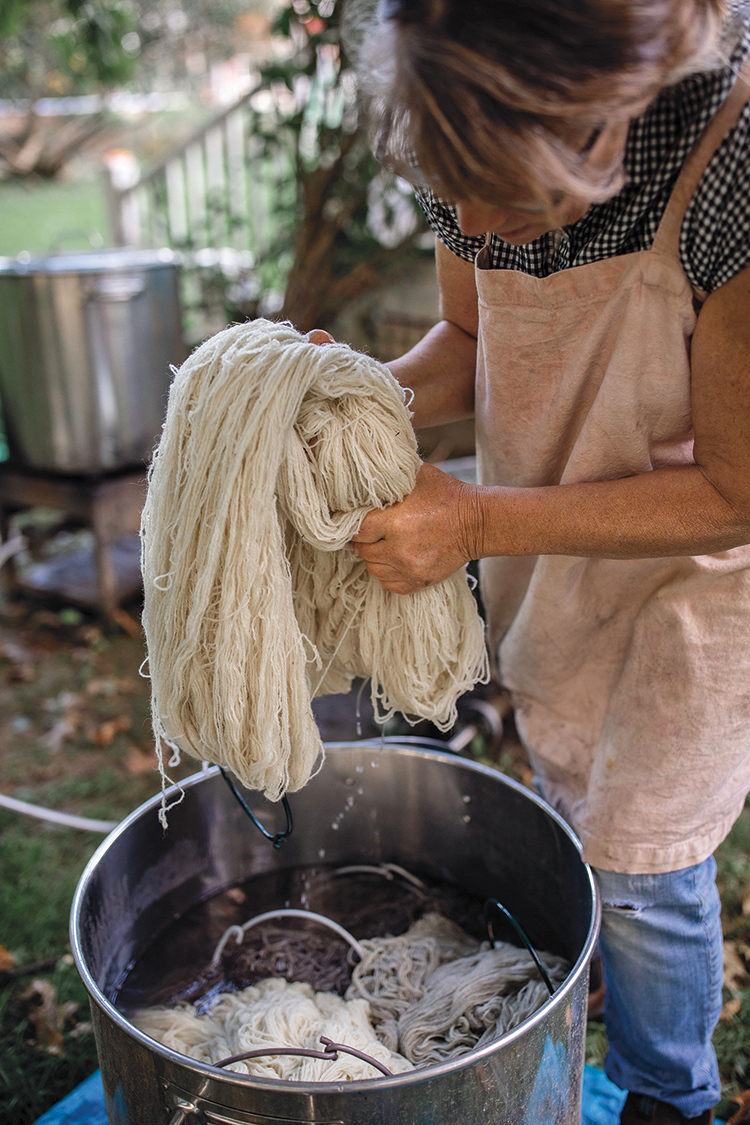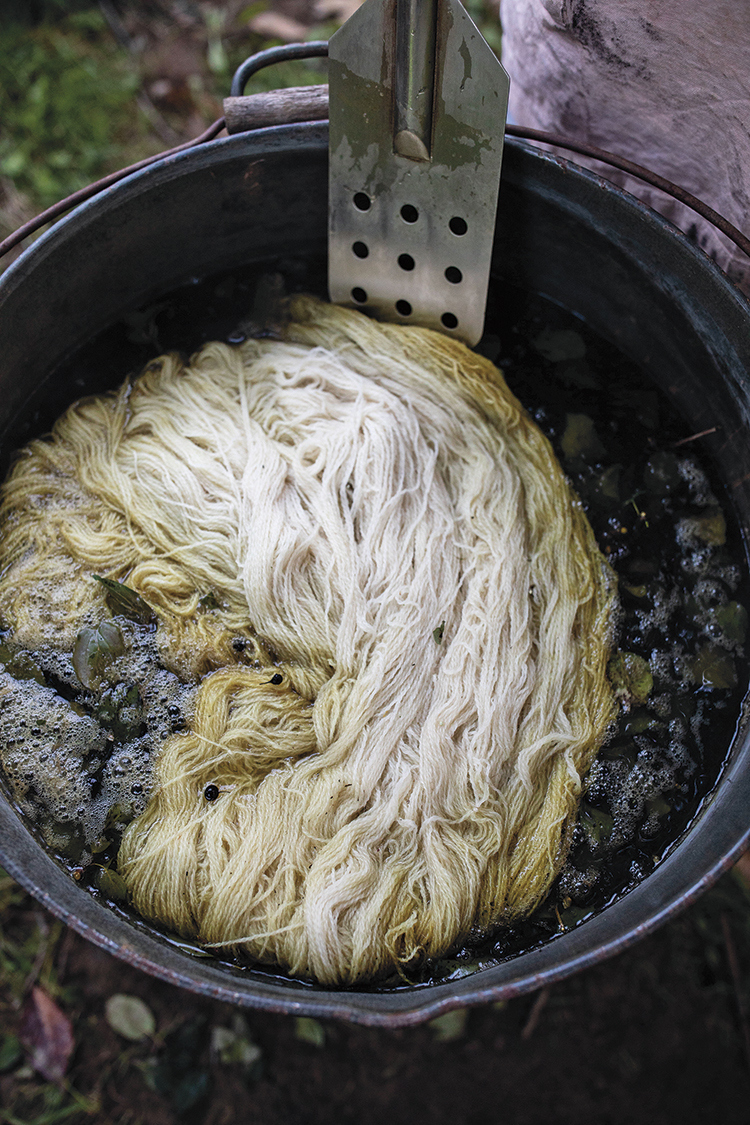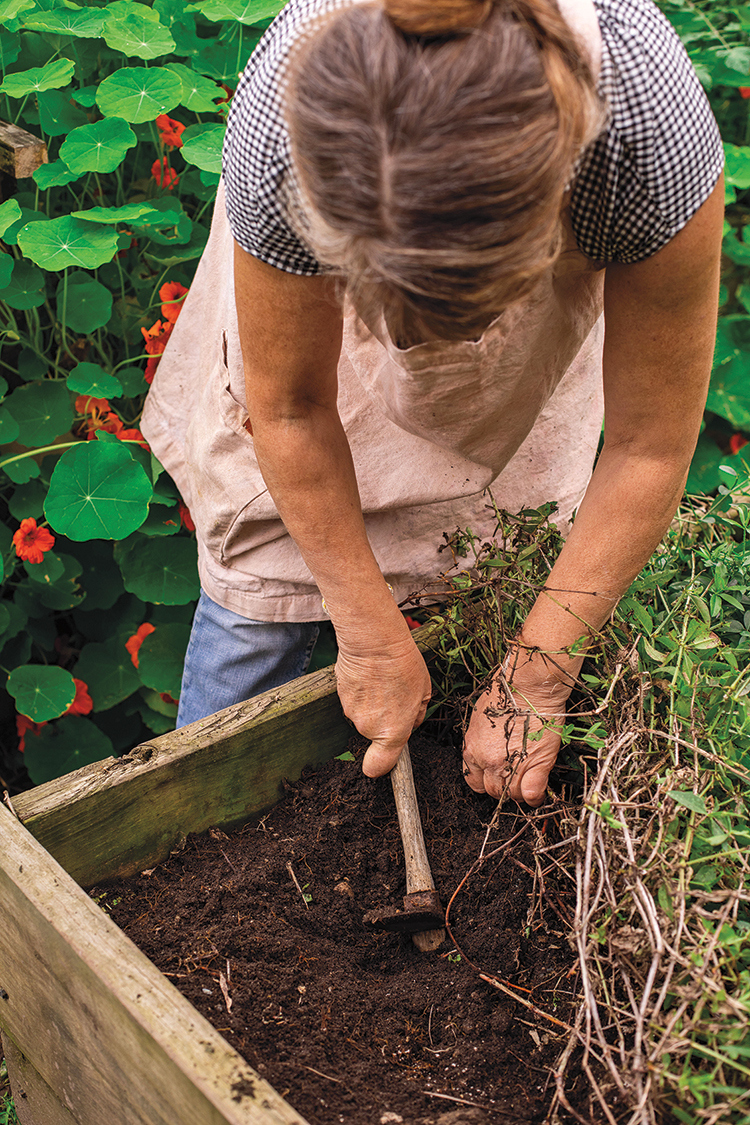I have been a fiber farmer since 2001 here in Shaftsbury, Vermont. My children and I learned what it was like to care for ruminants that grazed the pastures surrounding our home and turned grass into wool perennially with our hobby flock. In those first few years, our tiny flock would be shorn by a hired, seasoned sheep shearer who took the time to explain how and what he was doing and advise us.
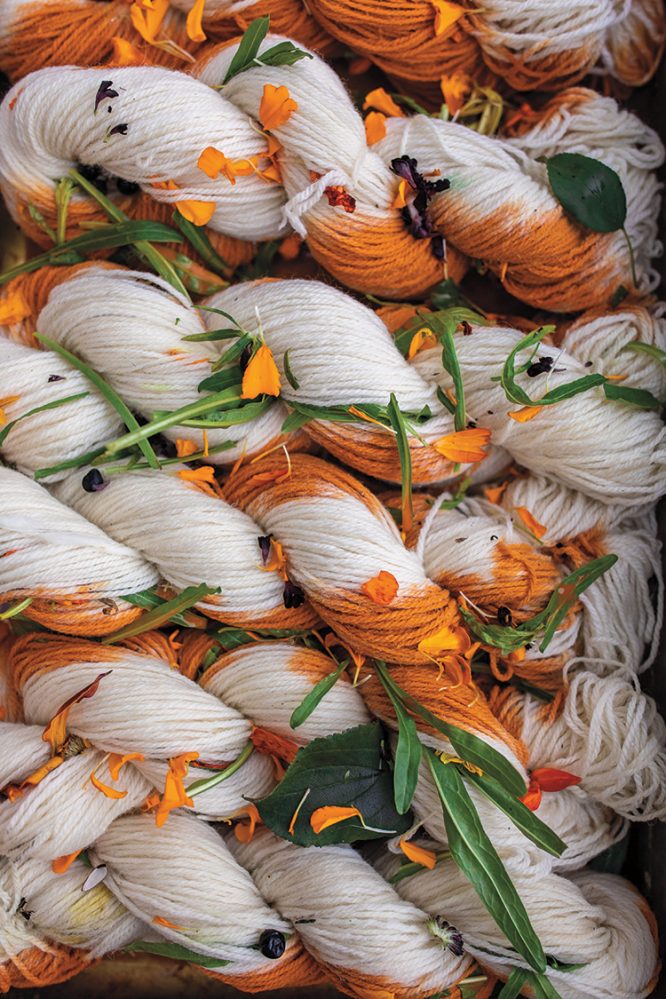
As time passed by, the shearer taught my daughter to shear, and now my daughter Char does the majority of the shearing of our much larger and diverse flock of wooly wonders. Our total harvest of fiber is much greater and more complex as compared to our simple beginnings.
In the production of yarns, there are many ways to prepare and twist the fiber to create just the right supply for just the right project. It is a culmination of stewardship, engineering, and ingenuity that bring us to the final recipe that produces each of the unique yarns that I then scour and dye, naturally, in my backyard.
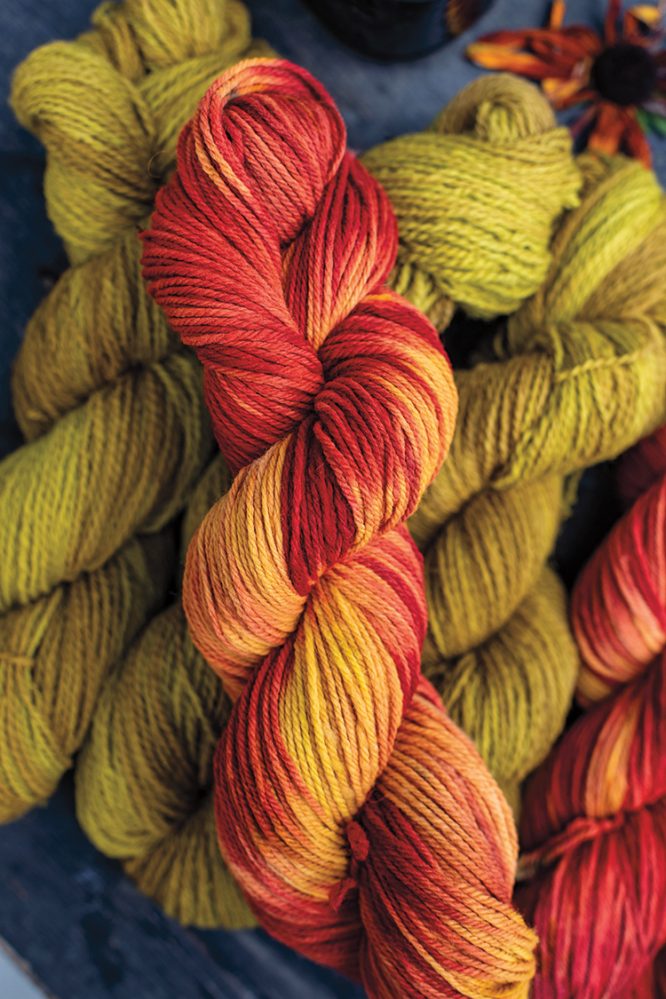
For the first several years of farming, I sent our flocks’ naturally colored, undyed wool to market. Fawns, greys, beiges, browns, deep chocolate colors that the sheep grew with no intervention from the dyer. A natural palette, which cannot be compared to. If you’re looking for the most exquisite pearl, champagne, ecru—look no further than the curls from the Cotswold, the Teeswater, the Shetland, or the Cormo fleeces. And if it’s black, dark chocolate, or grey-colored fabric that you want to weave, then lean into the alpacas, the colored Merinos, the Shaela, and Moorit-fleeced Shetlands to source your swatches.
Botanical dyeing was the only method of dyeing before the industrial age, and has been employed for over 2,000 years. Ancient Egyptians, Peruvians, Phoenicians, Romans, and dyers in China and India perfected dyeing naturally long before the development of synthetic dyes. But by the early 20th century, synthetic dyeing had replaced natural dyes, and the art and application had faded and receded.
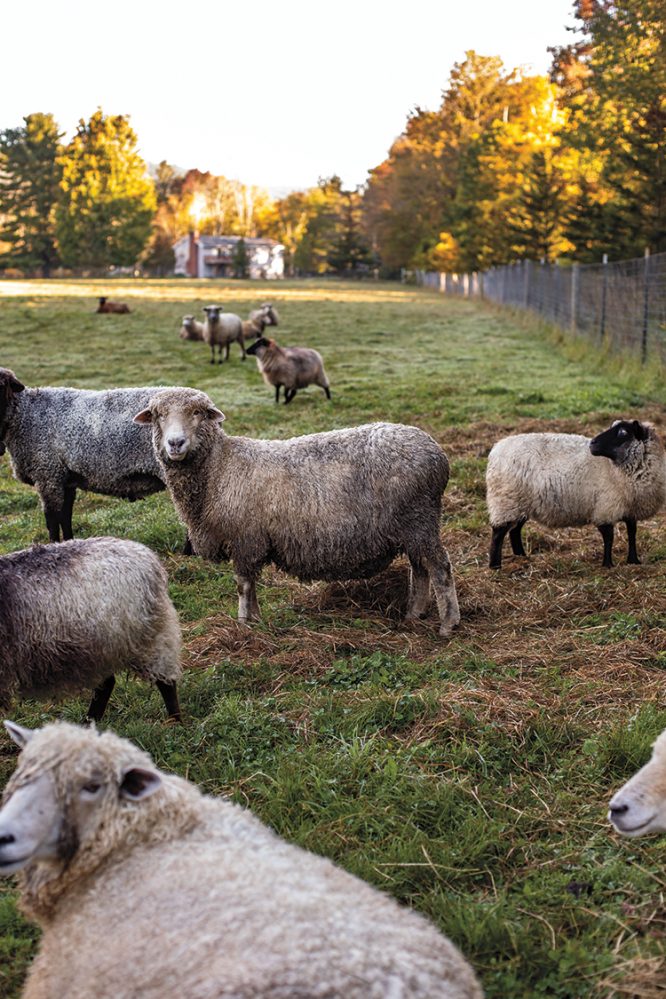
This work of raising fiber-producing animals is a vocation, and striving to leave the earth a little better than I found it has always been prominent in my thinking. I felt that when I discovered that beautiful colorways could be achieved without creating toxic runoff or damaging the earth’s resources, it was simple and clear that this would be how we would dye our farm’s yarns.
In 2010, I began to experiment. I took a course at a community college but also taught myself with books and experience. As a fulltime production farmer dyeing every single twist of yarn that my farm produced, I learned quickly how to manage the resources from our farm to get many colors from a few materials.
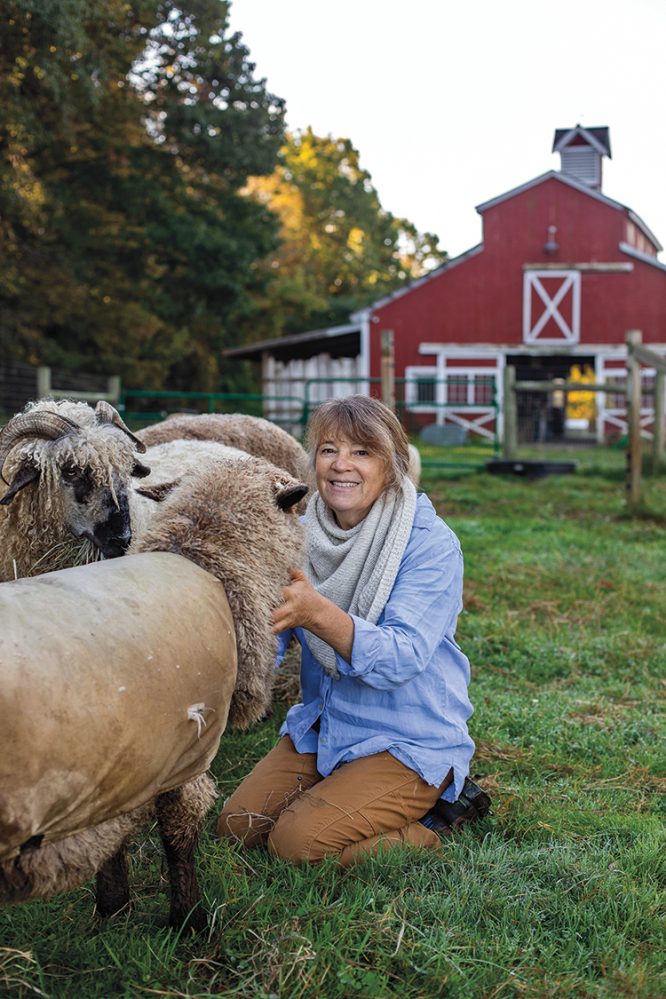
I harvested Buckthorn, Goldenrod, Nettles, Acorns, Oak leaves, Black Walnuts, and more from the farm and surrounds to add warm golds, greens, caramels, and browns that would color and combine for more complex shades. I grew Coreopsis, Calendula, Cosmos, Marigolds, Madder, Weld, and more from our dye garden to fill in the colors that I couldn’t find from foraging. So many yellows, corals, pinks, and reds from these blooms, seeds, and leaves than you could imagine, and then blues from Scabiosa Purpurea flowers, Woad and Indigo leaves, and Hopi Sunflower & Rudbeckia seeds…
By 2020, I had established an online shop and taught workshops on my farm and at a variety of venues, in addition to marketing my farm’s wool at in-person events. I took my in-person workshops and tailored them for virtual audiences, writing and demonstrating how to make color from nature in your kitchen, or your studio, or any space in between. If you wanted to dye your own wool or any protein fibers (silk) or cellulose fibers such as cotton, linen, or flax, I’d enthusiastically share what I have learned and how you can utilize simple materials and manage your time in exploring alchemy in your backyard such as I do.
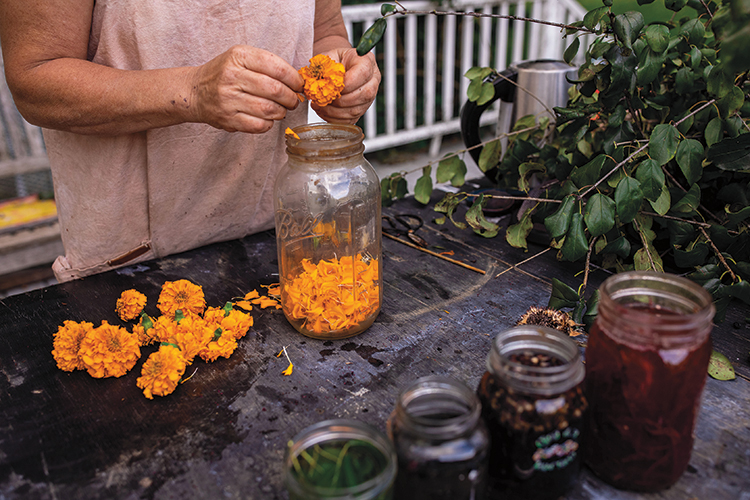
“What you do makes a difference, and you have to decide what kind of difference you want to make.”
—Jane Goodall
An important start to creating lasting color from sources in nature is to make sure to start with well-scoured fiber. The wool comes back from the mills, believe it or not, still somewhat soiled, though not noticeably so, and with the addition of spinning greases that need to be removed before the fiber will soak up the most color from whatever you have foraged, grown, or purchased to dye with. It is after several rinses that I feel sure that the yarns are clean that I will administer the next step of the process, which is to then mordant the fiber.
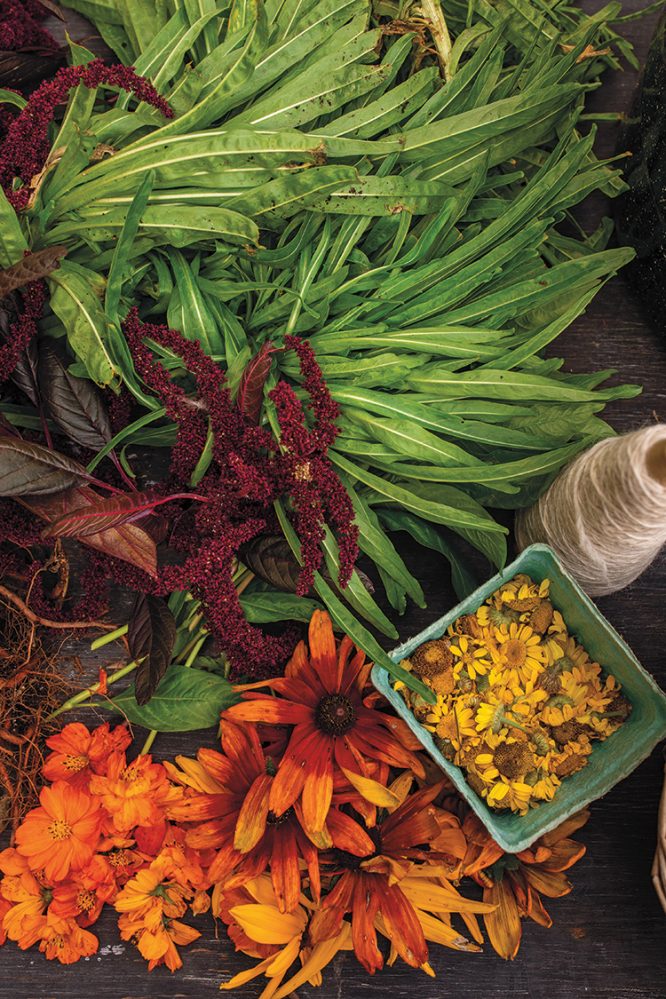
Mordanting is the act of preparing the material to bind to the natural dyes that will be used. A common mordant of Aluminum Sulphate (Alum) can be prepared by using a small percentage of powdered Alum dissolved in water to which I add the yarns to soak. Though applying heat to simmer the solution and yarns will expedite the process, I generally plan on allowing time to saturate the fiber for me. The fewer resources that I need to employ, such as fossil fuels for added heat or my own time for tending, the less impact on the environment and the more sustainable for all. So often, I will ‘set it and forget it’ and allow my yarns to sit in the kettle of mordant solution overnight before the dye-step.
Once the fiber has been mordanted, it is ready for adding dyes. I create dyes using the petals, leaves, roots, bark, fruits or nuts, stems, and stalks of the variety of forage-and-grown materials on my farm. My daughter Char and I cultivate a dye garden with many raised beds, which helps to keep the garden above the reach of the piggy, Princess Peppermint, and ducks that live amongst them. Princess Peppermint and the ducks are helpful to keep garden pests at bay, as well as keeping the weeds from growing in the pathways.
Filling my dye kettles full of flowers or creating jars of color with my harvest, I can now play with my palette and my prepared yarns. Sometimes I get requests for custom works, but mostly I am dyeing according to what is in season, what I know to be full of the height of its readiness for picking to extract pigment from, what I might have been successful with in the past or know to be a popular choice for the upcoming seasons.
I pick Buckthorn from the overgrown hedges alongside the pastures to use the leaves, the berries, the stems for the entire process from mordant to dye. The rich tannins in the bark and leaves will help the pigment stay and hold fast to the fibers; the berries will create the darkest blues and purples for staining beautiful shades.
If Hopi Sunflowers are very bountiful, then we will have lots of blues and purples to play with. The seeds will rapidly release inky color when submerged in simmering water, and by modifying it with iron or vinegar, I can coax it to blue or purple.
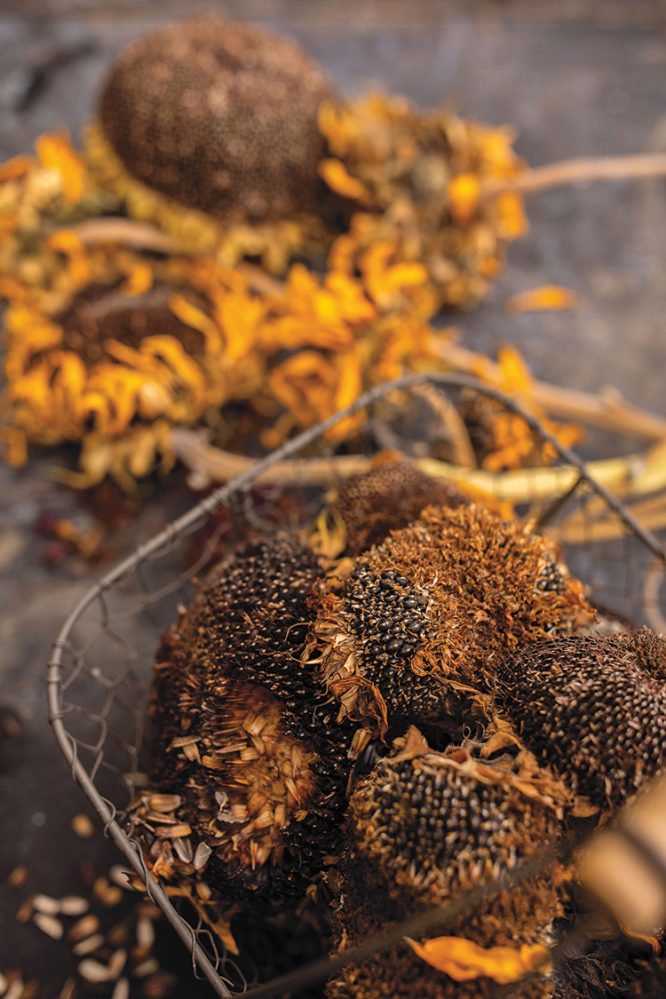
Similarly, I can add heat to Madder roots that I’ve grown to deepen them from coral pinks to brick reds or add cream of tartar to make it pop brighter and fresher as an overdye on an ecru-colored yarn. Or combine Weld leaves with Coreopsis petals to make vivid oranges.
Sometimes I enjoy twisting the bounty in and amongst the strands of beautiful wool and letting whimsy take over in my backyard dye studio. Just let the petals, the seeds, the stems, and leaves do their thing and trust that it will be beautiful.
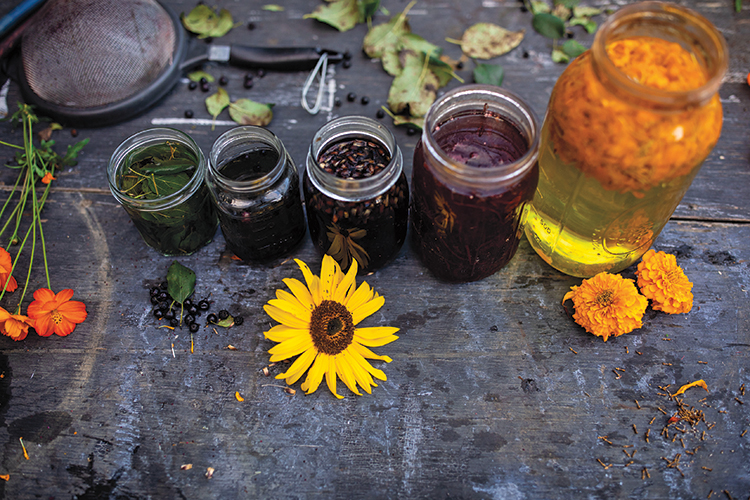
Coaxing the color with added heat from a flame at the kettle or allowing time to work its alchemy, the final stage is to rinse again when dyeing is complete.
I dry the skeins of bright or pastel-colored wool and then twist them into plump hanks and affix a farm tag for marketing. Ready for the next handmade sheep-to-shawl, farm-to-needle project.
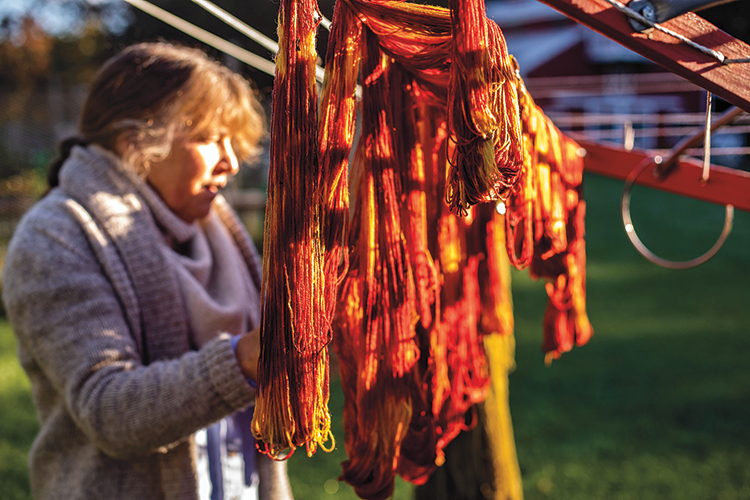
The whole while I am immersed in this process, my constant companion, Nessie, my Border Collie, lies under my table or runs alongside while we are gathering. She is at my heel, the flock is in eyesight, baah-ing occasionally, the garden is right there, birds, bees filling the air with their songs…these things are all a part of what we turn out into the world.
Why trouble to take such a slow and ancient approach to spinning yarns, dyeing with botanicals, insisting on this old-fashioned pace?
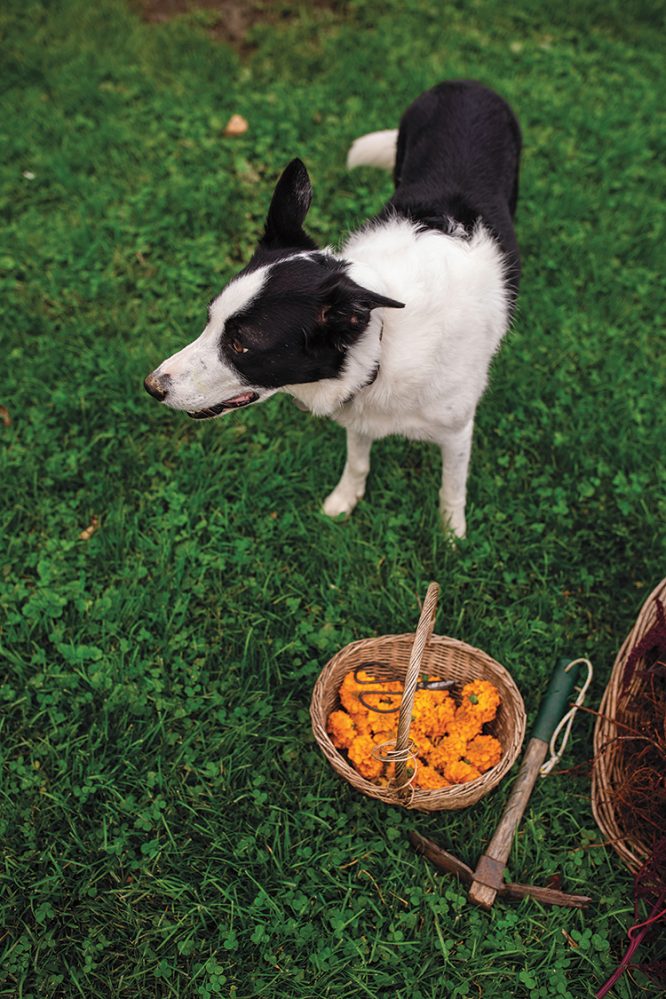
By caring for animals and humankind in a way that draws down carbon, returns it to the earth, and cleans up the atmosphere even a little bit, we can give back. By embracing natural fibers and color in a world gone wild with synthetics, we can nudge the earth to a greener space, a cleaner space, and, also, enjoy the beauty before us.
I believe it is in my genes, this incurable optimism. Encouragement found in the shining sun, flowers, warm breezes, and birdsong, the soft eyes of a gentle ewe.
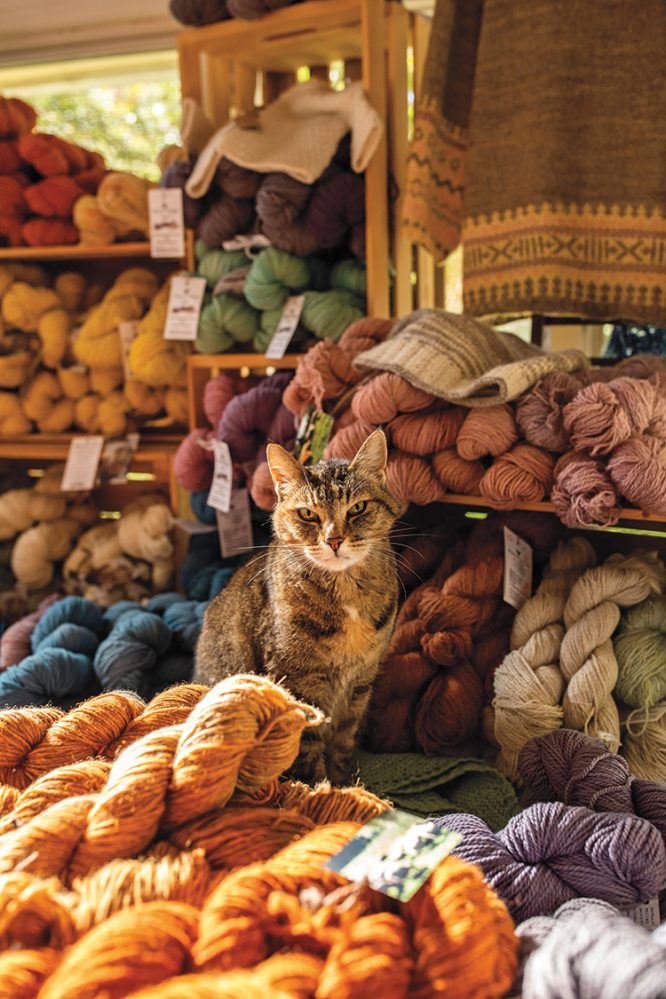
I have been a fiber farmer since 2001 here in Shaftsbury, Vermont. My children and I learned what it was like to care for ruminants that grazed the pastures surrounding our home and turned grass into wool perennially with our hobby flock. In those first few years, our tiny flock would be shorn by a hired, seasoned sheep shearer who took the time to explain how and what he was doing and advise us.

As time passed by, the shearer taught my daughter to shear, and now my daughter Char does the majority of the shearing of our much larger and diverse flock of wooly wonders. Our total harvest of fiber is much greater and more complex as compared to our simple beginnings.
In the production of yarns, there are many ways to prepare and twist the fiber to create just the right supply for just the right project. It is a culmination of stewardship, engineering, and ingenuity that bring us to the final recipe that produces each of the unique yarns that I then scour and dye, naturally, in my backyard.

For the first several years of farming, I sent our flocks’ naturally colored, undyed wool to market. Fawns, greys, beiges, browns, deep chocolate colors that the sheep grew with no intervention from the dyer. A natural palette, which cannot be compared to. If you’re looking for the most exquisite pearl, champagne, ecru—look no further than the curls from the Cotswold, the Teeswater, the Shetland, or the Cormo fleeces. And if it’s black, dark chocolate, or grey-colored fabric that you want to weave, then lean into the alpacas, the colored Merinos, the Shaela, and Moorit-fleeced Shetlands to source your swatches.
Botanical dyeing was the only method of dyeing before the industrial age, and has been employed for over 2,000 years. Ancient Egyptians, Peruvians, Phoenicians, Romans, and dyers in China and India perfected dyeing naturally long before the development of synthetic dyes. But by the early 20th century, synthetic dyeing had replaced natural dyes, and the art and application had faded and receded.

This work of raising fiber-producing animals is a vocation, and striving to leave the earth a little better than I found it has always been prominent in my thinking. I felt that when I discovered that beautiful colorways could be achieved without creating toxic runoff or damaging the earth’s resources, it was simple and clear that this would be how we would dye our farm’s yarns.
In 2010, I began to experiment. I took a course at a community college but also taught myself with books and experience. As a fulltime production farmer dyeing every single twist of yarn that my farm produced, I learned quickly how to manage the resources from our farm to get many colors from a few materials.

I harvested Buckthorn, Goldenrod, Nettles, Acorns, Oak leaves, Black Walnuts, and more from the farm and surrounds to add warm golds, greens, caramels, and browns that would color and combine for more complex shades. I grew Coreopsis, Calendula, Cosmos, Marigolds, Madder, Weld, and more from our dye garden to fill in the colors that I couldn’t find from foraging. So many yellows, corals, pinks, and reds from these blooms, seeds, and leaves than you could imagine, and then blues from Scabiosa Purpurea flowers, Woad and Indigo leaves, and Hopi Sunflower & Rudbeckia seeds…
By 2020, I had established an online shop and taught workshops on my farm and at a variety of venues, in addition to marketing my farm’s wool at in-person events. I took my in-person workshops and tailored them for virtual audiences, writing and demonstrating how to make color from nature in your kitchen, or your studio, or any space in between. If you wanted to dye your own wool or any protein fibers (silk) or cellulose fibers such as cotton, linen, or flax, I’d enthusiastically share what I have learned and how you can utilize simple materials and manage your time in exploring alchemy in your backyard such as I do.

“What you do makes a difference, and you have to decide what kind of difference you want to make.”
—Jane Goodall
An important start to creating lasting color from sources in nature is to make sure to start with well-scoured fiber. The wool comes back from the mills, believe it or not, still somewhat soiled, though not noticeably so, and with the addition of spinning greases that need to be removed before the fiber will soak up the most color from whatever you have foraged, grown, or purchased to dye with. It is after several rinses that I feel sure that the yarns are clean that I will administer the next step of the process, which is to then mordant the fiber.

Mordanting is the act of preparing the material to bind to the natural dyes that will be used. A common mordant of Aluminum Sulphate (Alum) can be prepared by using a small percentage of powdered Alum dissolved in water to which I add the yarns to soak. Though applying heat to simmer the solution and yarns will expedite the process, I generally plan on allowing time to saturate the fiber for me. The fewer resources that I need to employ, such as fossil fuels for added heat or my own time for tending, the less impact on the environment and the more sustainable for all. So often, I will ‘set it and forget it’ and allow my yarns to sit in the kettle of mordant solution overnight before the dye-step.
Once the fiber has been mordanted, it is ready for adding dyes. I create dyes using the petals, leaves, roots, bark, fruits or nuts, stems, and stalks of the variety of forage-and-grown materials on my farm. My daughter Char and I cultivate a dye garden with many raised beds, which helps to keep the garden above the reach of the piggy, Princess Peppermint, and ducks that live amongst them. Princess Peppermint and the ducks are helpful to keep garden pests at bay, as well as keeping the weeds from growing in the pathways.
Filling my dye kettles full of flowers or creating jars of color with my harvest, I can now play with my palette and my prepared yarns. Sometimes I get requests for custom works, but mostly I am dyeing according to what is in season, what I know to be full of the height of its readiness for picking to extract pigment from, what I might have been successful with in the past or know to be a popular choice for the upcoming seasons.
I pick Buckthorn from the overgrown hedges alongside the pastures to use the leaves, the berries, the stems for the entire process from mordant to dye. The rich tannins in the bark and leaves will help the pigment stay and hold fast to the fibers; the berries will create the darkest blues and purples for staining beautiful shades.
If Hopi Sunflowers are very bountiful, then we will have lots of blues and purples to play with. The seeds will rapidly release inky color when submerged in simmering water, and by modifying it with iron or vinegar, I can coax it to blue or purple.

Similarly, I can add heat to Madder roots that I’ve grown to deepen them from coral pinks to brick reds or add cream of tartar to make it pop brighter and fresher as an overdye on an ecru-colored yarn. Or combine Weld leaves with Coreopsis petals to make vivid oranges.
Sometimes I enjoy twisting the bounty in and amongst the strands of beautiful wool and letting whimsy take over in my backyard dye studio. Just let the petals, the seeds, the stems, and leaves do their thing and trust that it will be beautiful.

Coaxing the color with added heat from a flame at the kettle or allowing time to work its alchemy, the final stage is to rinse again when dyeing is complete.
I dry the skeins of bright or pastel-colored wool and then twist them into plump hanks and affix a farm tag for marketing. Ready for the next handmade sheep-to-shawl, farm-to-needle project.

The whole while I am immersed in this process, my constant companion, Nessie, my Border Collie, lies under my table or runs alongside while we are gathering. She is at my heel, the flock is in eyesight, baah-ing occasionally, the garden is right there, birds, bees filling the air with their songs…these things are all a part of what we turn out into the world.
Why trouble to take such a slow and ancient approach to spinning yarns, dyeing with botanicals, insisting on this old-fashioned pace?

By caring for animals and humankind in a way that draws down carbon, returns it to the earth, and cleans up the atmosphere even a little bit, we can give back. By embracing natural fibers and color in a world gone wild with synthetics, we can nudge the earth to a greener space, a cleaner space, and, also, enjoy the beauty before us.
I believe it is in my genes, this incurable optimism. Encouragement found in the shining sun, flowers, warm breezes, and birdsong, the soft eyes of a gentle ewe.













